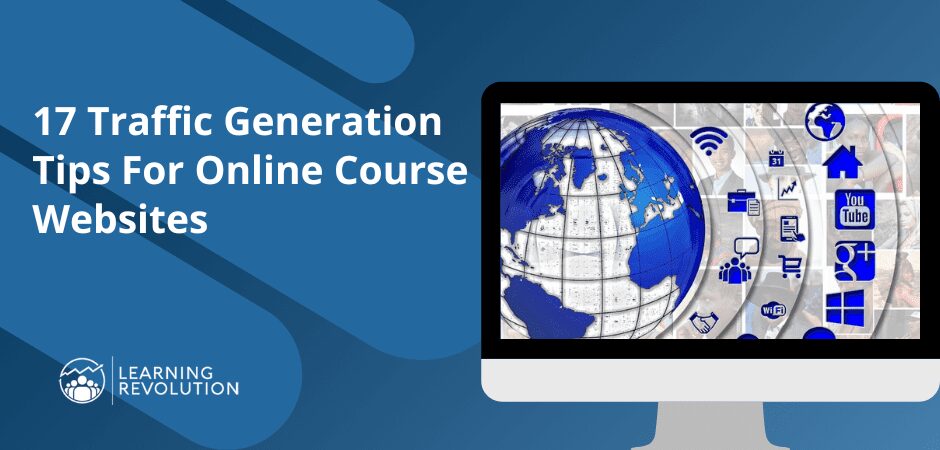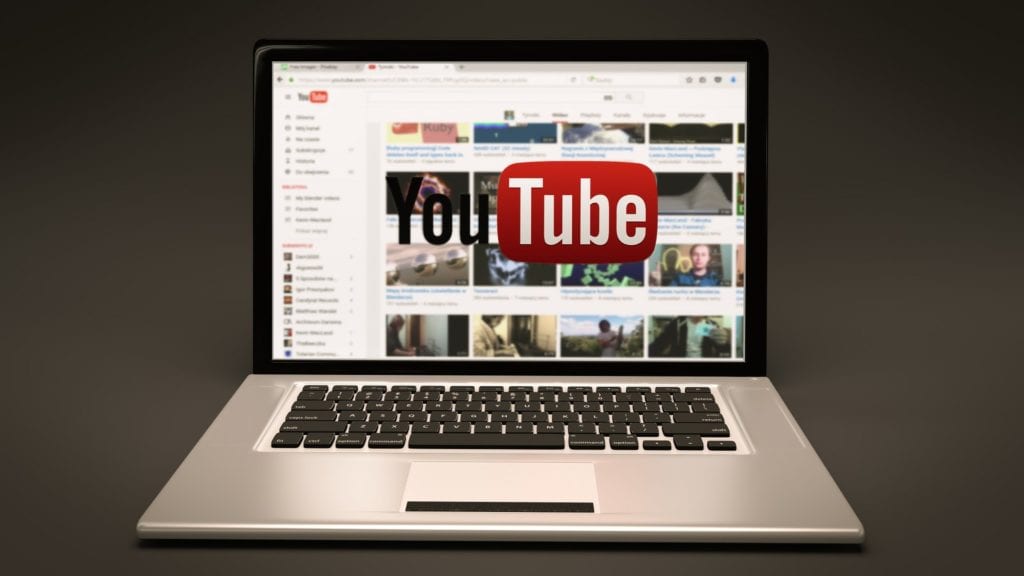

You may be leveraging Google SEO, but are you on top of YouTube SEO? If not, you may be leaving a lot of visibility – and possibly a lot of revenue – on the table.
Search engine optimization (SEO) is fundamental to performing well in Internet search engine results and it enables businesses to avoid maxing their budgets on a2dvertising costs whenever they bring a new product to market. Getting ranked on the first page of Google is the holy grail for any business that finds new customers online, and the situation is no different for edupreneurs and other types of expertise-based businesses.
But many businesses overlook SEO when it comes to uploading their YouTube videos, reducing their organic reach and ultimately making them more reliant on paid ads if they want to be sure their videos are seen. Considering what a powerful channel YouTube can be for building your audience and monetizing your expertise, this is a major oversight.
So, if you’ve been overlooking how SEO impacts your success on YouTube, it’s time to make a change get your video content optimized for SEO. This article will show you how.
How Google and YouTube work together
The reason SEO matters so much on YouTube is simple: it’s owned by Google. That means Google prioritizes YouTube results on search engine results pages (SERPs). Almost any search — and the majority of searches looking for educational services — feature video results from YouTube at the very top of the SERPs.
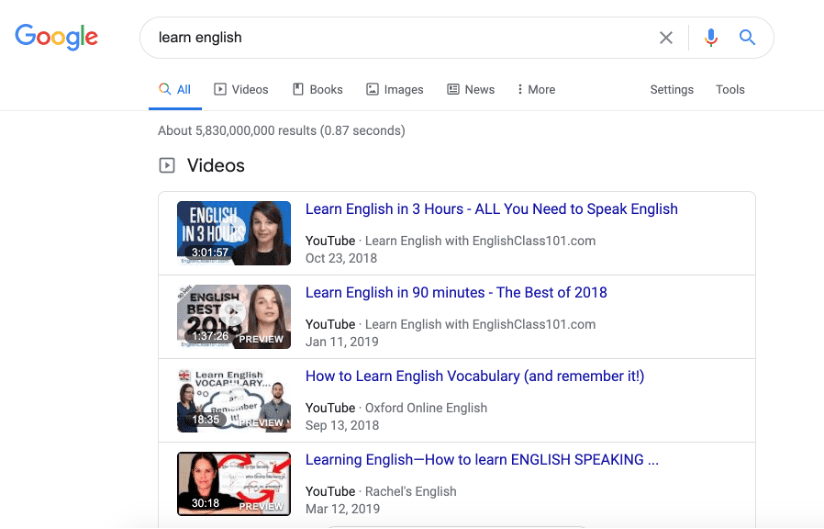

This is huge for edupreneurs, because although the top spots on SERPs may have already been taken by larger and more established websites, you can still get your content to rank right at the top of Google by publishing videos on YouTube.
Getting your video featured on Google, however, is more complicated than simply pressing Publish. Google uses SEO clues from YouTube, including the title, description, and tags, in order to provide the most relevant results to any search query, exactly as it does with web pages.
Developing a keyword strategy for YouTube SEO
So how do you do SEO for video content? In short, the trick is to develop a successful keyword strategy and then optimize the video title, description, and tags to convince search engines your video is the most relevant for that keyword query. On-page SEO sounds deceptively simple (in truth, it is!) but getting it right involves a lot of research, trial and error.
Short-tail and long-tail keywords for YouTube
The first thing any edupreneur needs to optimize their SEO is a keyword strategy. Without one, it’s difficult to know how to market a video, or to determine what works and what doesn’t.
Simply put, a keyword is just a search term people use to find content similar to yours. Really they should be called “key phrases.” If you’re publishing a series of videos on learning English, for example, “how to learn English,” or just “learn English,” would be great keywords to rank for.
There are two types of keywords: short-tail and long-tail, which refers to the number of clauses each keyword or phrase contains. “Learn English” is a short-tail keyword, because it only contains one clause. “Learn English online,” contains two clauses. “Learn English online for French speakers” is longer again, because it contains three clauses.
Many keyword strategy articles will suggest attempting to rank for short-tail keywords because they have the greatest reach. While that’s true, they are also the most competitive, and often produce the lowest conversion rates. Typically long-tail keywords are searched by people who are much further along the buyer’s journey than short-tail keywords. Someone with a general idea about learning a new language might search “Learn English,” whereas somebody searching “Learn English online best course for French speakers,” is clearly far more committed to the endeavor and has a clearer idea what they want, making that lead much more likely to convert into a learner for your course.
Searching for keywords using YouTube
YouTube is particularly helpful for edupreneurs looking to develop a keyword strategy, because they provide a Search Suggest feature that includes the most commonly searched words and phrases relevant to your initial query.
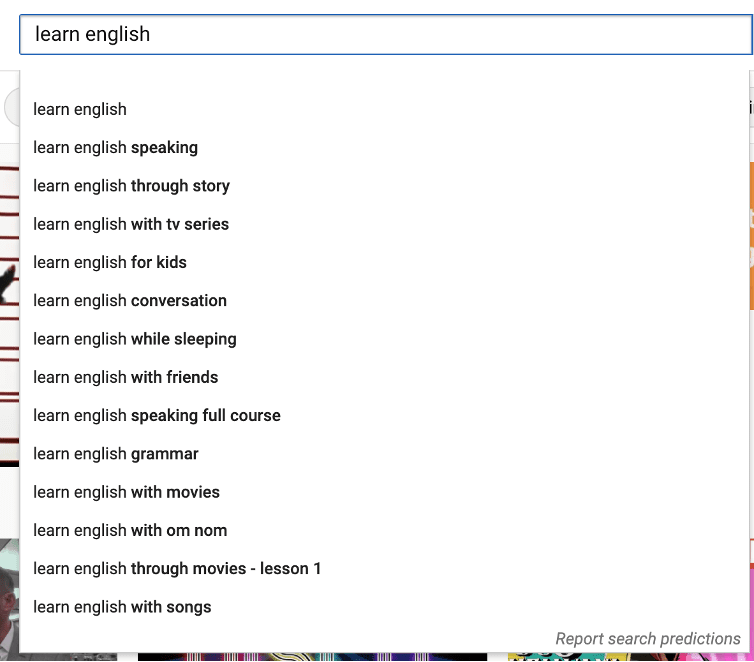

The first step you should take to develop a keyword strategy is therefore to look at the keywords that YouTube suggests. These are search terms used most commonly by YouTube users, and are a great starting point for developing your keyword strategy.
Another way to find keywords is to look at your competitors’ YouTube videos. Because YouTube (and Google) are highly individualized, it’s best to do this using an incognito browser, in order to eliminate your past search history from the algorithm. Sort search engine results by popularity in order to find the videos that have been watched by the most people, and are therefore mostly likely to be optimized for the keyword you used.
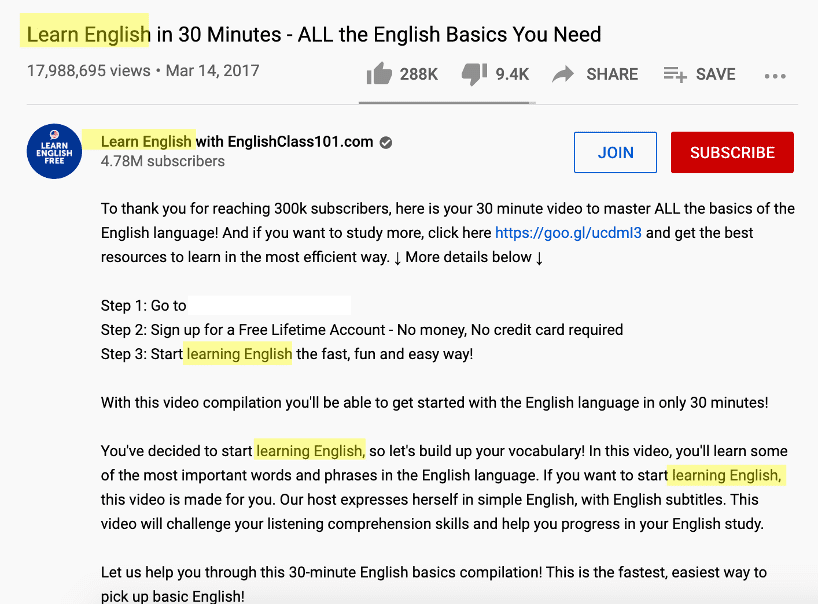

Note the repetition of the keyword “learn English,” along with other related phrases. The keyword appears in the title, the channel name, and three times in the description, increasing its relevance in SERPs.
Simply repeating a single keyword, or groups of keywords, isn’t enough to rank highly on search engines — in fact, many search engines can spot this behavior, known as “keyword stuffing,” and penalize it instead. However it is important to include your keyword within your video title and description in an organic way in order to tell search engines what the video is about.
Using Google to check keyword competition
Next, check out the competition. More specifically, how much competition there is. “Learn English,” for example, produces about 4.9 billion YouTube results. A new channel isn’t likely to perform well optimizing for that keyword, however much work they do. That’s because search engines (and the YouTube algorithm) prioritize the reputation of a site/video in the search results, giving more established channels an advantage when it comes to ranking highly with new content.
This is where long-tail keywords are your friend. “Learn English” might be saturated, but “Learn English online best course for French speakers” produces 1.1 billion results, and “Learn English from French in a month,” 577 million. That’s still a lot of competition, but simply by adding extra clauses to your target keywords, you can remove 90 percent of the competition.
The final step in developing your keyword strategy is confirming that your keywords are actually used. It’s easy to create low-competition long-tail keywords by adding increasingly specific clauses, but if your keywords are so niche that nobody uses them, it doesn’t matter how high you rank in SERPs.
A good free way to check keyword competition is to use Google’s Keyword Planner tool. Although designed to help accounts run ads on Google, this tool also provides general users with keyword search volume data, which is invaluable as you’re building a keyword strategy. Simply search your keywords with the Planner and check out the number of average monthly searches to see how popular the keywords are, and how many other campaigns target that keyword.
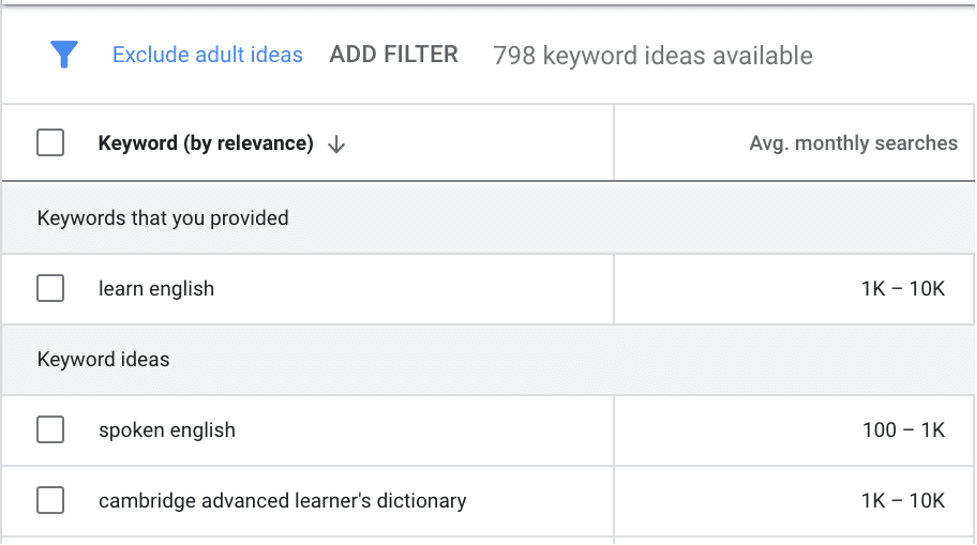

Google also provides suggestions related keywords, giving you more ideas to consider as you develop your strategy.
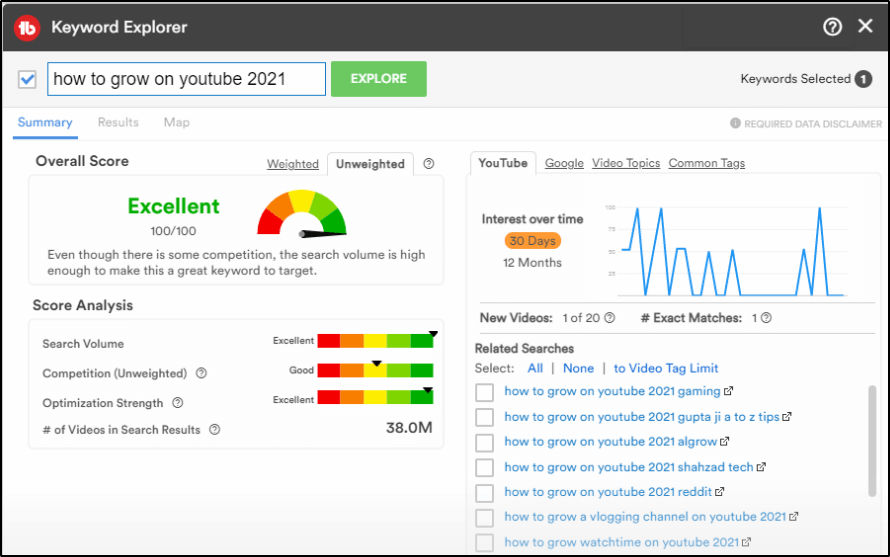

Optimizing your YouTube video for SEO
Now you’ve got a keyword strategy in place, it’s time to optimize your videos to perform for those keywords.
Keyword planning is a great way to generate new content ideas for your YouTube channel (and edupreneur business as a whole!), so you should be able to tailor a video lesson to each keyword you have chosen. When writing the script for your video, it’s important to use your keywords so they become part of the content itself. YouTube generates automated closed captions for videos, and the algorithm will then use those captions to “read” the content, in much the same way an algorithm parses website pages and blog posts. Using your most important keywords and phrases throughout your video is a great way of signaling to search engines that your content is relevant to the search query.
Tip: Don’t rely solely on computer-generated captions. While they do the heavy lifting for you, it’s worth the time to review the captions and correct any transcription errors. This not only makes for a better viewing experience, but improves your SEO results by ensuring the right content is being associated with your video.
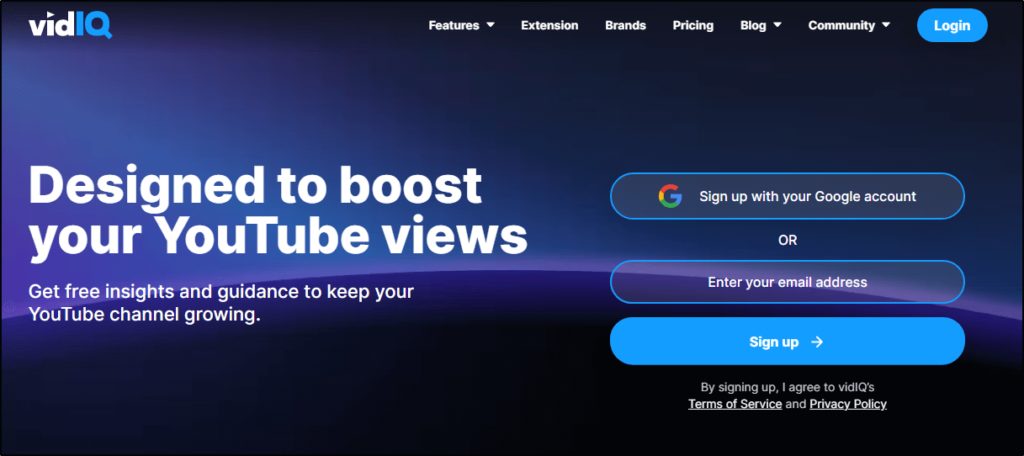

Using keywords in YouTube titles and descriptions
As well as using your keywords in your video script, they should also feature in your video title and description. Avoid keyword stuffing, and focus on using the phrases in a way that reads naturally to a human. “Best video learn English online” has clearly been written to talk to a computer, not a person, and it will turn actual viewers off. “Learn English the best way — An online video guide to native speaking” is more persuasive to viewers, and still contains the important keywords you want to include.
As a rule of thumb, YouTube titles should be less than 70 characters in length (about 10-15 words), and the beginning words are the most important, so always try to lead with your primary keyword. All other things being equal, “The best way to study — Learn English online” would perform worse than the above example, because of the order of the keywords in the title.
Follow the same principles when writing your YouTube video description — include the keywords early into the description, but focus on speaking to viewers first and algorithms second. The first 130 characters of your description show on the YouTube results page as a preview, so make your first sentence really pop. This is your best chance to convert a search result into a video viewer.
Tag your YouTube video
The days of tagging being the gold standard of SEO are long gone, but while YouTube allows the tag functionality, it’s worth using. Your tags should be relevant to your keywords and video subject, as well as to your broader channel subject. This is a good place to include variations of your chosen keyword, and attach more short-tail keywords to your content.
Tip: If you use #hashtags in your YouTube video description, the first three will appear under the video as hyperlinks. The links direct to a YouTube search page for that specific tag, and can help your video rank higher for those search queries.
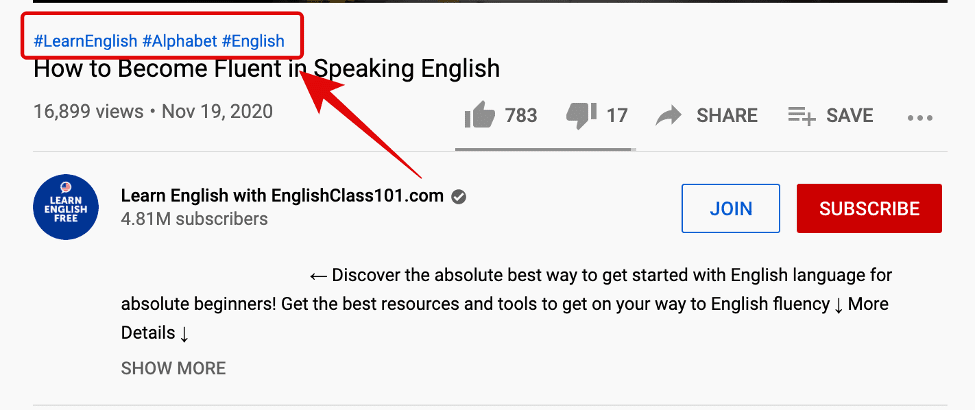

Increasing audience retention on YouTube
Once your video is optimized for your YouTube SEO strategy, it should start attracting viewers. Your next task is to keep them.
As an edupreneur, past experience as a teacher and public speaker will help you craft compelling content that keeps viewers engaged. On YouTube, this is known as “audience retention,” and is a key metric the site uses to rank videos. The higher the retention (i.e. the longer your viewers spend watching your video), the higher it will be shown in SERPs.
On YouTube, content tends to move at a faster pace than you might be used to. Videos with short, snappy introduction sequences that get straight to the point fare much better than more branded content with longer intros. This will prevent a large drop-off of viewers in the first few seconds. First impressions matter on YouTube, so start every video with a bang.
Video length also plays a role in audience retention metrics. It’s much easier to get a 100 percent watch rate on a video that’s less than two minutes long than on an hour-long video on the same subject. However be wary of going too short, because Google tends to rank longer videos higher in search results. A study by Animoto suggested the ideal length for a YouTube video was 6-8 minutes, and while the exact length of your videos will depend on your subject and the specific lesson, try to avoid producing lecture-length content if you want viewers to remain engaged.
Another way to boost retention is to whet your viewers’ appetites about upcoming content. Structuring your videos into short, simple sections with a recap of the material and the overall outline at the end of each part is a powerful memory aid that also keeps viewers engaged.
These reminders are sometimes called “open loops,” or more properly the Zeigarnik effect, and are based on the discovery that “a task once started creates a sort of ‘task tension’ in our brains, and that tension leads to better recognition of ideas relevant to the open task.” Essentially, once we commit to something — such as learning new information by watching a YouTube video — our minds become “switched on” to that subject until its conclusion. Structuring your video around check-in points in the lesson serves to remind viewers what they’re learning and keep them watching until the lesson is over.
Reviewing your YouTube SEO strategy
Boosting your views on YouTube using SEO is a three-part challenge:
- Identify relevant search phrases (keywords) for your subject
- Optimize videos to rank highly on SERPs for those keywords
- Attract and retain real-world viewers
The purpose of the entire strategy is point 3: to attract and retain viewers. Your business needs learners, and YouTube is a channel you can use to attract them.
It’s easy to lose sight of the end user when you’re elbow-deep in keyword strategies and algorithm data, but everything search engines use to find and rank content is done with the end user in mind. A good YouTube SEO strategy increases the chances of your content being seen by the largest number of potential viewers, but finding the trigger that makes them click on your video over the competition, and subscribe to your channel for more content in the future, is the real secret to successful search engine performance.
See also:
- Using SEO to Sell Online Courses
- How to Start a YouTube Channel and Grow It
- How to Make Money on YouTube | 10 Proven Strategies
- A Guide to YouTube Advertising for Course Creators
- 23+ Best YouTube Tools to Grow and Monetize Your Channel
Table of Contents



